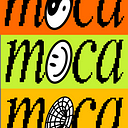“To visualize the invisible is traditionally the main goal of art.”
“The reduction of the artwork to nothingness, to emptiness, to point zero, opens the gaze of it’s spectator to the artwork’s context.”
- Boris Groys
Yes, there is nothing there. But what is it? It’s a canvas, painted white. A canvas, unpainted. It is a work, erased, then framed. It is an empty frame, a blank screen, a transparent pixel. So what is “nothing?”
Walter Benjamin’s famed concept of art’s essence frames this particular pursuit: that which remains when all else falls away is the “aura” of a work of art. When the art is “nothing” and yet provokes deep thought, it is an ode to aura for aura’s sake, as well as a brilliant and concise proof of Benjamin’s statement. It is the pure distillation of the “why” in art.
In the tradition of other works exploring medium and aura via the production of “nothing,” ArtonymousArtifakt’s “∅” presents “nothing” in a way that speaks volumes to the material circumstances of medium and viewership in digital art. “∅” is “nothing” in a novel medium: a transparent pixel minted on the blockchain. Confronted with a blank pixel, on any given screen, in any given place, one is forced to reckon with the thingness of this new form of absence.
Kazimir Malevich, Yves Klein, and Robert Rauschenberg (all historically significant in their own disparate ways) presented their famous “nothings” in ways that questioned the historical progression (or, really, the lack thereof) of art while simultaneously stripping art down to its essence. Malevich, with solid blocks, Klein, an empty room, and Rauschenberg, first by presenting three solid white parallel canvases, then by erasing the work of a contemporary icon and presenting its absence. These works let the trappings of art fall away to investigate what remained: that in art which is indestructible. These are all potent and profound explorations of art’s distilled character that have had lasting and transformative effects on discourse and theory.
Art is “the medium for investigating the eventfulness of events,” as proven by the fact that the presentation of “nothing” in varied forms and from varied approaches is itself a rich and storied exercise, carrying with it a rich and running discourse for the last century and change. Pure distillation of that investigation: the presence of art in an exploration of absence. It is clearly an event of some sort — we are here pondering it now. That is revelatory and impactful on its own; art is not necessarily the physical product, nor is it essentially an aesthetic product. These pieces are an exercise in eventfulness, in nothingness, in being, in aura.
Is it context and process dependent? Often. Usually. Who can say?
One can start with nothing as the subject and go everywhere. The depth here on its own also upends the conventional criticism of digital art in general: is the profundity and range of “nothing” not itself an obvious indicator of art’s total independence from form, medium, temporality, and technique? How then can someone turn their nose up at digital art?
The reaction stirred by these works, the potential depth of the conversation (independent of value judgments on the aesthetics of the piece itself) more than justifies its existence via the profound questions it asks, themselves spun-off of profound questions asked in pieces preceding it.
Digital “nothing” is an entire added dimension of nothingness — a new form of “nothing,” which, of course, makes it something. What is a blank space on a screen when it is also code, when illuminated pixels represent it? Is it more or less “nothing” to have my screen powered off? The blockchain adds yet another layer to the question here, as it seems to add a sort of “thingness” to the piece: it is nothing, sure, but it has its given place and time on the blockchain.
Further, when so much traditional art is held as pure financial assets in freeports, crated away, out of sight, and inaccessible — what is that, then? Its reality is purely financial, market-based, on a balance sheet. Those pieces have ceased entirely to function as art, in a philosophical sense. Artonymous’ transparent pixel is filled with infinitely more artistic life and being than a Picasso spending a lifetime in a crate in Singapore.
This can also serve as a commentary on what digitization has rendered absent or decreasingly visible: there is much lost in digitization and growing ephemerality. Simultaneously, however, digitization has dispersed the act of viewing, has cast it to the wind — this is a “nothing” that I can “see” at any given moment on a smartphone or a computer screen.
“The viewer finds on the internet only what he or she wants to find.” The viewer finds in a transparent pixel (in a blank space, in nothingness, in absence) only what they want to find. It is certainly true of the internet. It is both the promise and a pitfall of online culture. Is that also true of art, essentially? To a certain degree, certainly. To which degree is, I suppose, ambiguous. And isn’t that the point?
“∅” is M○C△’s first token swap for a piece done with a collector (Pindar Van Arman), and the potential, the possibility, the profound “nothingness” that is the piece reflects the growth and evolution of M○C△ itself.
Thoughts? Ideas? Find us here: https://forum.museumofcryptoart.com/
